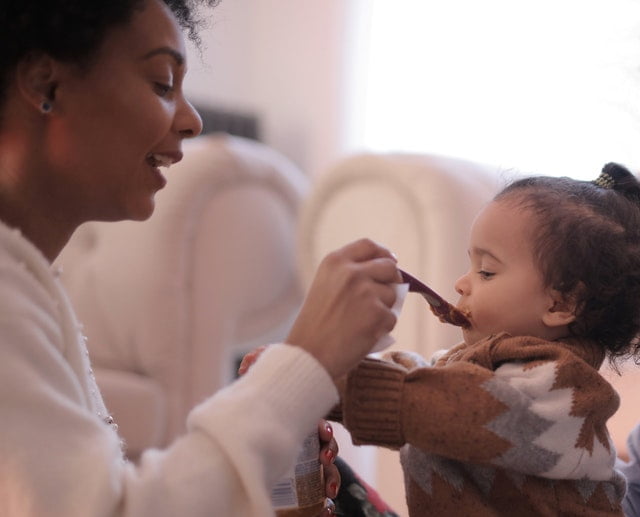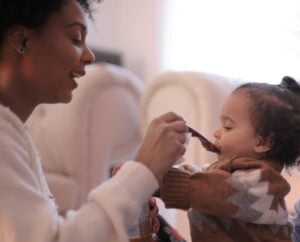A GUIDE TO FINGER FOODS FOR BABIES
- Published on:
- Last update: 09 October 2023

FINGER FOODS FOR BABIES: A COMPLETE GUIDE
Finger foods for babies are a good way to introduce new foods. Have you been introducing purees to your baby, and now they are ready for the next phase of their culinary journey? Can your baby not resist taking pieces of food from your hand? Have you determined that your baby is ready for solid food but is not sure what to feed him/her?
Here’s where you’ll find everything you need. We have guides for babies as young as nine months. You’ll learn everything you need to know about finger foods for babies or feeding your baby finger foods.

FINGER FOODS: WHEN TO START
Once you have taught your child to eat purees when you are following a traditional weaning approach, you can introduce finger foods for babies. It varies from baby to baby, but it usually occurs between 7-9 months in most cases. In this stage, your baby is getting better at grasping her palm, developing her pincer grasp, and bringing her hands to her mouth.
You will need to experiment with the approach you take to introduce finger foods to your child, but the average age is between 6 and 8 months. You shouldn’t wait too long to introduce finger foods – one study found that babies who had been exposed to lumpy solids after 9 months ate fewer food groups at 7 years of age than those who had been exposed to lumpy foods between 6 and 9 months.
However, depending on factors such as premature birth or any developmental concerns, your baby might need to start later than this range. You should always speak to your pediatrician about starting solids, including finger foods.

HOW TO PREPARE FINGER FOODS
Following are several tips for finger foods for babies such as baby fruit, vegetables, grains, proteins, and carbohydrates. It may have slipped the mind but if you forgot your favorite cooking method, then feel free to use it. Below are some general guidelines regarding the preparation of finger foods for babies.
SOFT FOODS:
To make finger foods, they need to be soft enough to squeeze between your fingers. Soft food is best for your baby’s first foods so he or she can easily gnaw, suck, chew, and move the food around his mouth.
COOKING METHOD:
Mangoes, bananas, avocado, and other soft foods may already be soft enough for a baby. Other hard fruits and vegetables will need to be steamed or roasted.
SERVING SIZES FOR FINGER FOODS:
It is convenient for babies 6-9 months to eat foods cut into 2-3 inch strips, about the size of two adult fingers, so that they can use their palmar grasp. Your baby can handle pea-sized portions of food comfortably between 9 and 12 months old if you chop them into small pieces.
HOW TO START FINGER FOODS WITH BABY
Don’t know where to begin when it’s time to give your baby their first solid finger food? There are a few practical steps you can take to ensure that your first feeding is successful.
Your baby should always be fed in a highchair or booster that offers good trunk, hip, and foot support. You should place a footrest nearby and ensure that their hips and knees are positioned at 90 degrees.
Start with 1-3 foods at a time and progress from there. Never put too much food on one tray or plate at one time. For a beginning eater, too much food can sometimes be visually overwhelming since we eat with both our mouths and eyes.
If food is placed directly on a highchair tray or table, this is safe. Furthermore, you can use the adorable silicone divider plates and bowls from your baby shower, but this is not required.
Good first food should be soft and ripe fruits like bananas and avocados or veggies like sweet potatoes and carrots that have been cooked soft.
Foods should be cut into pieces about the size of two adult fingers so they can be easily grasped. Provide your baby with a preloaded utensil with one of the above foods pureed on it. Following are a few of the first foods we like for baby-led weaning.
Your baby’s cues should always be followed, so feed them accordingly. Rather than dictating how much your baby should eat, allow her to decide whether or not she wants to eat a portion. In order to establish good eating habits later on in life, your baby needs to be able to develop and express both hunger and fullness.
HOW TO KEEP BABIES SAFE
Knowing how scary it can be for parents to introduce solid food to their babies, I appreciate your advice. It is possible to make feeding your baby a wonderful experience for both of you if you take the right precautions and learn what to expect.
- Choking-risk foods should be avoided.
- If your baby is eating, you should always supervise them – sit with them and don’t multitask.
- For all meals and snacks, the baby should be seated upright, not reclined. When the baby gets sleepy while eating, remove food from him.
- When an adult is supervising your baby in the backseat, you cannot eat in the car seat.
- Babies shouldn’t be allowed to eat while on the move. Once your baby is crawling or walking, do not allow him or her to hold food in their mouths or hold it in their hands.
- Before serving, make sure the food is at the right temperature.
When your baby is done eating, check their mouth. During the learning process, some babies seem to pocket food in their cheeks or get food stuck to the roof of their mouths. You can encourage your baby to keep chewing, to spit it out if necessary, or to drink water or milk if you still see food remaining.
Don’t stick your fingers in your baby’s mouth to get the food out – we want the baby to learn how to take care of the food on his or her own. Your baby’s food might also become lodged further down in his or her throat if you stick your finger to his mouth. Not only that, but it will be harder to dislodge.
FIRST FINGER FOODS FOR BABY
Have a hard time deciding which foods to offer first? There are 10 foods that are nutrient-dense, easy to make, and taste great for your baby’s first foods. The following list offers more finger foods for babies to eat and explore.
- Avocado: cut into slices or small pieces
- Banana: peeled and cut into long strips or rolled in cereal or puffs crushed up.
- Sweet Potatoes: Steam them for 10-12 minutes or roast them.
- Salmon: Baked at 350 degrees Fahrenheit for 10-12 minutes then removed the skin and shredded for babies.
- Broccoli: either steam it for 8-10 minutes or roast it.
- Meat: shredded or ground, or small pieces of meat chopped into small pieces.
- Eggs: hard-boiled and chunked, omelet strips, or egg cups.
- Yogurt: Feed baby with a spoon or let her explore with her hands.
- Oats: Cook and cool in small round shapes, then serve to the baby in patties.
- Green Beans: steamed or roasted for eight to ten minutes.
TIPS ON FINGER FOOD FOR BABIES
It’s common for parents to instinctively shred baby food into teeny-tiny pieces when their babies are first attempting self-feeding at six months – probably to avoid choking. At the time of starting solid foods, infants have not yet developed their pincer grip and have only developed a palmar grasp – the reflexive closing of their hand around an object.
This makes it extremely difficult for them to manage smaller pieces. It is best to prepare their food in larger portions. Start with finger foods that are about the size and shape of apple slices or potato wedges, so that each piece is about two fingers wide and about one inch long.
Image source: Photo by Lukas from Pexels
Reference: The My Little Eater
Share this post:

